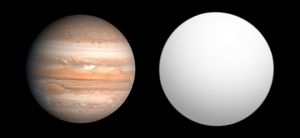- COROT-9b
-
COROT-9b Extrasolar planet List of extrasolar planets 
Size comparison of COROT-9b with Jupiter. Parent star Star COROT-9 Constellation Serpens Right ascension (α) 18h 43m 09s Declination (δ) +06° 12′ 15″ Apparent magnitude (mV) 13.7 Distance 1500 ly
(460 pc)Spectral type G3V Mass (m) 0.99 ± 0.04 M☉ Radius (r) 0.94 ± 0.04 R☉ Temperature (T) 5625 ± 80 K Metallicity [Fe/H] -0.01 ± 0.006 Orbital elements Semimajor axis (a) 0.407 ± 0.005 AU
(~60.9 Gm)~0.885 mas Periastron (q) 0.36 ± 0.02 AU
(~54 Gm)Apastron (Q) 0.45 ± 0.02 AU
(~67 Gm)Eccentricity (e) 0.11 ± 0.04 Orbital period (P) 95.2738 ± 0.0014 d
(~0.26084 y)Orbital speed (υ) 46.6 ± 1.0 km/s Inclination (i) > 89.9° Argument of
periastron(ω) 37+9
−37°Time of transit (Tt) 2,454,603.3447 ± 0.0001 JD Physical characteristics Mass (m) 0.84 ± 0.07 MJ Radius (r) 1.05 ± 0.04 RJ Density (ρ) 960 ± 170 kg m-3 Surface gravity (g) 1.93 ± 0.33 g Temperature (T) 250–430 K Discovery information Discovery date March 17, 2010 Discoverer(s) Deeg et al. (COROT) Detection method Transit Discovery site Polar orbit Discovery status Announced Database references Extrasolar Planets
Encyclopaediadata SIMBAD data COROT-9b is an exoplanet orbiting the star COROT-9, approximately 1500 light years away in the constellation Serpens.[1] COROT-9b's distance of nearest approach to its parent star of approximately 0.36 AU is the largest of all known transiting planets, with an orbital period of 95 days. The transit of this planet lasts 8 hours. The planet is at a distance from its star where there is a strong increase in albedo as the temperature decreases, because of the condensation of reflective water clouds in the atmosphere. This suggests its atmosphere may be locked into one of two states: a cloudless state with temperatures between 380 K (107 °C; 224 °F) and 430 K (157 °C; 314 °F), or covered in water clouds with a temperature in the range 250 K (−23 °C; −10 °F) to 290 K (17 °C; 62 °F).[1]
Contents
Discovery
COROT-9b was discovered by combining observations from the CoRoT satellite,, which looks for a small dip in starlight as a planet passes in front of its parent star, and the ESO HARPS instrument. This discovery was announced in 2010 on St. Patrick's Day, after 145 days of continuous observations in summer 2008.[2]
-
Animation of an artist’s impression.
Mass and size
COROT-9b has a mass of 0.84 times that of Jupiter (MJ) as determined from HARPS spectroscopy, and has a radius of 1.05 times that of Jupiter (RJ) as determined from photometry of the transit light curve. This implies that this planet has a density of 96% that of water, and surface gravity 1.93 times that of Earth.
Atmosphere and interior
Since COROT-9b is the first temperate giant exoplanet found by the transit method, astronomers will be able to study the atmosphere of a temperate giant planet for the first time,[2] examining the composition of clouds, the composition of the atmosphere, temperature distributions, and even some details of the interior of the planet. The atmosphere of this planet is presumably dominated by hydrogen and helium (like Jupiter and Saturn), with up to 20 Earth masses of other elements including water, as well as and rock at high temperatures and pressures.[2] The authors of the COROT-9b discovery paper refer to the planet as a class II ("water cloud") or class III ("clear") atmosphere planet, as described by the Sudarsky extrasolar planet classification.
See also
- COROT is a CNES space mission to discover planets using the photometric transit method. It is in polar orbit around the Earth.
- COROT-7b is a rocky super-Earth.
- HD 80606 b is the longest period (but much more eccentric than CoRoT-9b) transiting planet.
- GJ 1214 b is a transiting super-Earth found by MEarth Project.
References
- ^ a b Deeg, H. J.; Moutou, C.; Erikson, A.; et al. (2010), "A transiting giant planet with a temperature between 250 K and 430 K", Nature 464 (7287): 384–387, Bibcode 2010Natur.464..384D, doi:10.1038/nature08856, PMID 20237564.
- ^ a b c "First temperate exoplanet sized up". 2010-03-17. http://www.astronomy.com/asy/default.aspx?c=a&id=9675. Retrieved 2010-03-18.
External links
 Media related to CoRoT-9 b at Wikimedia Commons
Media related to CoRoT-9 b at Wikimedia Commons- "Cool Jupiter exoplanet found". University of Oxford. March 18, 2010. http://www.ox.ac.uk/media/news_stories/2010/100318.html.
- "CoRoT-9b, a temperate exoplanet" - DLR Portal, 2010.march.17
Categories:- Extrasolar planets
- Exoplanets discovered in 2010
- Transiting extrasolar planets
- Gas giant planets
- Serpens constellation
Wikimedia Foundation. 2010.

